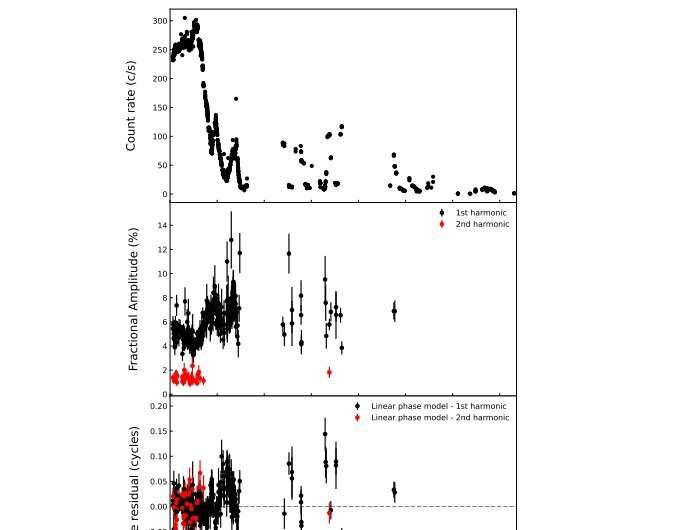December 27, 2022 report
Research investigates the latest outburst of pulsar SAX J1808.4−3658

Using the Neutron Star Interior Composition Explorer (NICER) onboard the International Space Station (ISS), an international team of astronomers has inspected the recent outburst of an accreting millisecond X-ray pulsar known as SAX J1808.4−3658. Results of the study, published December 19 on the preprint server arXiv, shed more light on the nature of this source.
X-ray pulsars exhibit strict periodic variations in X-ray intensity, which can be as short as a fraction of a second. Accreting millisecond X-ray pulsars (AMXPs) are a peculiar type of X-ray pulsars in which short spin periods are caused by long-lasting mass transfer from a low-mass companion star through an accretion disk onto a slow-rotating neutron star.
Astronomers perceive AMXPs as astrophysical laboratories that could be crucial in advancing our knowledge about thermonuclear burst processes. However, AMXPs are relatively rare and to date only a few dozen objects of this type have been identified using NICER and other space observatories.
SAX J1808.4−3658 (or SAX J1808 for short) was discovered in 1996 with the X-ray satellite BeppoSAX during an X-ray outburst. Two years later, when X-ray pulsations were detected from this source, it was classified as the first accreting millisecond X-ray pulsar. The object, located some 11,400 light years away, consists of a neutron star in an orbit with a brown dwarf companion (with a mass of about 0.05 solar masses). The orbital period of the system was measured to be around 2.01 hours.
SAX J1808 has undergone ten approximately month-long outbursts with a 2–3 years recurrence period, since its discovery. Recently, on August 19, 2022, another outburst of this pulsar started, which was noticed by the Monitor of All-sky X-ray Image (MAXI) instrument onboard the ISS. A group of astronomers, led by Giulia Illiano of Rome Observatory in Italy, began to monitor SAX J1808 shortly after the outburst commenced, hoping to get more insights into the properties of this pulsar.
During the most recent outburst, SAX J1808 after decaying from a peak luminosity of approximately one undecillion erg/s in about a week, it entered in an about one month-long reflaring stage. Similar behavior was seen also in previous outbursts.
By analyzing the current outburst, the astronomers confirmed that the spin frequency of SAX J1808 decreased at an average rate of −0.001 pHz/s, as was suggested by previous studies. This result is consistent with energy losses expected from a 100 YG cm3 rotating magnetic dipole.
The study found that for the first time in the last twenty years, the orbital phase evolution showed evidence that the orbit of SAX J1808 has contracted since the last epoch. The astronomers noted that the long-term behavior of the orbit can be described by an 11-second modulation with a 21-year period.
The new outburst of SAX J1808 is expected to occur in 2025. The authors of the paper underlined that observations of this upcoming outburst will be crucial in order to confirm their findings regarding the orbital evolution of this pulsar.
More information: Giulia Illiano et al, Timing analysis of the 2022 outburst of the accreting millisecond X-ray pulsar SAX J1808.4−3658: hints of an orbital shrinking, arXiv (2022). DOI: 10.48550/arxiv.2212.09778
Journal information: arXiv
© 2022 Science X Network



















